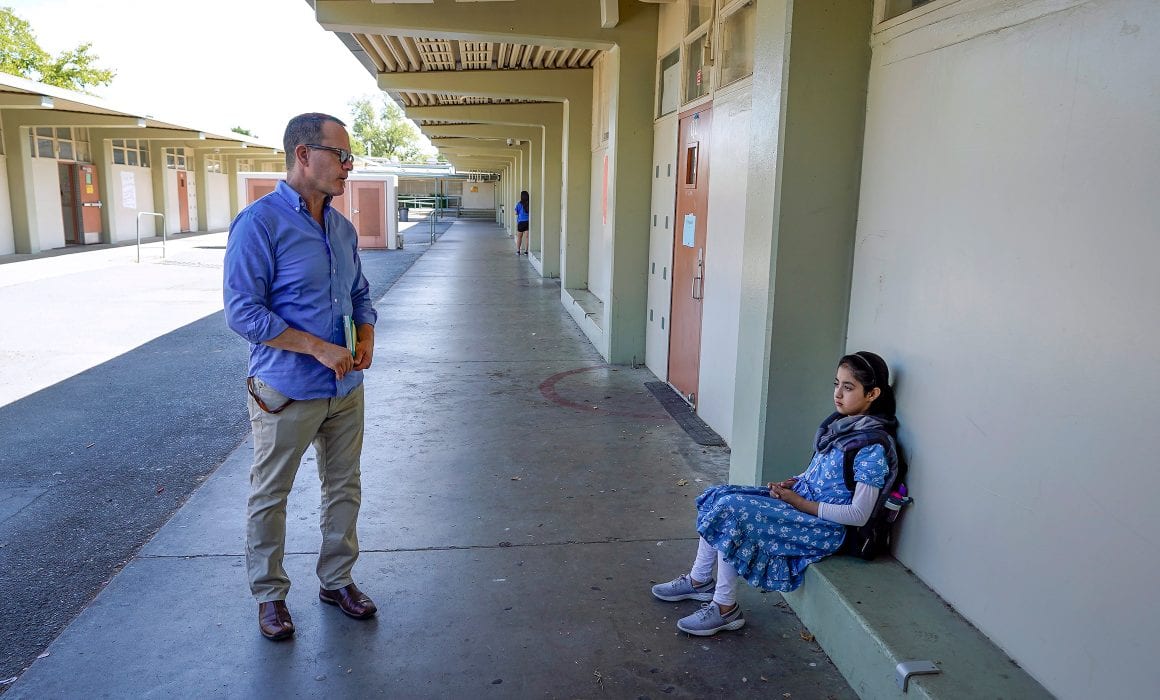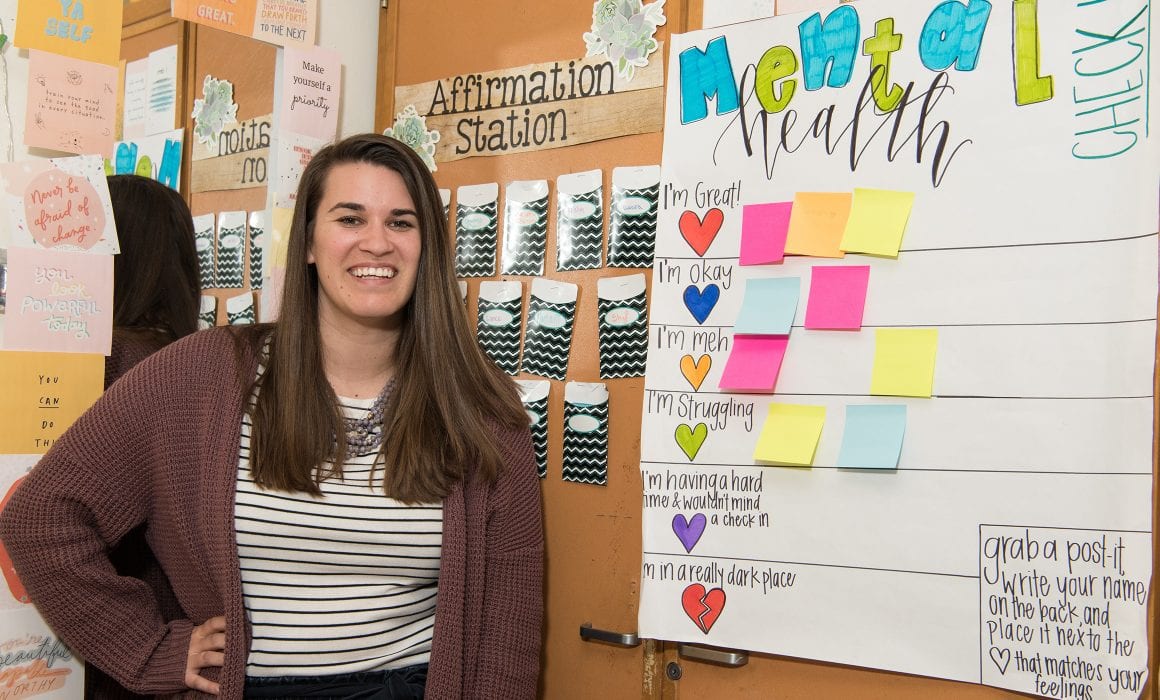Supporting the Whole Student
Comprehensive and engaging student support services are vitally important for the academic, college, career and social emotional development and growth of students.
Student Support Services Professionals work with classroom teachers, parents, administrators and ESPs to provide multi-tiered domain interventions such as classroom lessons, small group counseling, individual counseling and crisis counseling. They also provide consultation, collaboration and resources that aid in the development of learning for all students, which includes school climates that are conducive to student safety, social, emotional well-being and intellectual support of academic and career goals.
Student Support Services Professionals can include instructional facilitators, library media specialists, school counselors, licensed professional clinical counselors, nurses, school psychologists, social workers and speech pathologists.
What is the Role of Student Support Service Professionals?
Quality student support services foster positive relationships among educators and students, and help increase a students’ attachment to school. They also serve as additional positive adult role models, which is an important link between students, their families, school resources and community-based health and social services.
CTA believes that students’ social-emotional needs must be addressed before effective teaching and learning can take place. When implementing site-level approaches to student discipline or the development of social competencies, CTA believes that it is crucial to involve teachers and credentialed support staff such as counselors, psychologists, nurses and social workers in the development and implementation of such programs.
Student Support Services Committee
The Student Support Services Committee studies and recommends policies and procedures for consideration by CTA governance bodies in the following areas: school counseling and guidance, nursing/health services, speech pathology, psychology, social work, library services, and welfare and attendance services.
Pupil Support Services Team
CTA believes all school districts should have at least one Pupil Support Service Team. This team should be composed of a school nurse, a psychologist, a credentialed counselor, a social worker, a speech therapist, a welfare attendance worker and an audiologist. The team would ensure equal access to academic and support services for all students in order to provide a comprehensive delivery of services and develop programs and strategies that address school climate issues.
School Nurses
School nurses are registered nurses with a health services credential, a baccalaureate and post-graduate education related to school health issues. School nurses provide a link between health and education.
School nurse responsibilities include but are not limited to:
Health Appraisals, Medical Referrals, Health Education, Screenings: Vision, Hearing, Scoliosis, Dental, Student Health Counseling, Referral Follow-up, Crisis Intervention, Sports Physicals, Communicable Disease Control, Health Record Maintenance, Specialized Physical Health Care, Emergency Care, Medication Administration, Staff In-service, Staff Health Counseling, First Aid, Staff CPR Certification, Staff First Aid Certification, Social Welfare Referral, Child Abuse Reporting, Special Education
School Psychologists
School psychologists are credentialed personnel who have training in both psychology and education. Their training and skills are used to team with educators, parents and other mental health professionals to guarantee that every child learns in a healthy, safe and supportive environment.
School psychologist responsibilities include but are not limited to:
Provide easily accessible, cost effective mental health services, Provide intellectual, academic, social and emotional assessments, Use intervention and prevention techniques to work with children and families, Provide assistance to teachers in classroom management, learning theory and individual student needs, Provide in-service trainings in learning and behavior management, Foster tolerance, understanding, and appreciation of diversity in the school community.
School Librarians
School librarians are credentialed teachers with an additional Library Media Teacher credential. A direct correlation can be made between improved student achievement and school library programs. School libraries and librarians support reading and literacy initiatives.
School librarians support learning to read and reading to learn. School librarian responsibilities include but are not limited to:
Collaborate with classroom teachers in designing lessons in finding and using information, Teach students to use technology and to evaluate electronic information, Instruct students in the effective location, evaluation and communication of information in all formats, Help students select books for class assignments and free reading, Develop school library collections of print and non-print materials to meet state and local curriculum standards, Provide access to library materials and technology for students, parents and teachers throughout the day.
School Counselors

School counselors are credentialed in pupil personnel services. School counselors work collaboratively; benefiting students, parents, teachers, administrators and the overall community.
School counselor responsibilities include but are not limited to:
Develop, plan, implement and evaluate school counseling, guidance and attendance programs, Advocate for high academic, career, personal and social development of all students, Provide school wide (student, family and staff) prevention, intervention and crises strategies and counseling, Provide consultation, training and staff development to teachers and parents regarding student needs and child welfare and attendance laws, Act as a liaison between teachers, parents and other school staff and community resources (including law enforcement and social services) to facilitate successful student development, including referrals for special education services, Interpret student records and tests, Address school policies and procedures that inhibit academic success, Disseminate financial aid and scholarship information.
*Child Welfare and Attendance counselor must have a Masters Degree in counseling, school social work or school psychology.
School Social Workers
School social workers are credentialed personnel with a Masters Degree in social work. School social workers identify and provide interventions for students and families that assist in creating positive learning environments for students.
School social worker responsibilities include but are not limited to:
Assess factors interfering with the student’s ability to achieve and implement strategies for improvement, Identify and provide intervention strategies for children and their families; including counseling, case management, attendance and crisis intervention, Participate in Student Success Team (SST) process, Participate in the development of individualized education plans (IEP), Consult with teachers, administrators and other school staff regarding social and emotional needs of students, Coordinate family, school and community resources on behalf of students.
Understanding the Impact of Trauma on Our Students
As the number of students with trauma increases, educators are turning to approaches that focus on relationships and empathy.
More and more of our students are coping with the impact of traumatic events in their lives — including chronic homelessness and ongoing abuse, the detention or incarceration of a family member, destructive natural disasters, and shootings and other violent acts in communities. Trauma severely affects their ability to learn and grow, and often results in disruptive behaviors. Many educators are turning to trauma-informed practices and establishing trauma-sensitive schools to reach these students and help them succeed.
“Behavior is a symptom of a larger problem. Creating a strong relationship with the student is essential to helping them be successful.”
— Christa Maldonado
Defining Child/Youth Trauma
The National Child Traumatic Stress Network says trauma results when a child/youth feels intensely threatened by an event they are involved in or witness. Events include:
- Bullying
- Community violence (shootings, bombings, or other types of attacks)
- Complex and early childhood trauma (repeated and prolonged exposure to trauma-inducing situations such as abuse, neglect, poverty, etc.)
- Domestic violence
- Disasters
- Refugee trauma
- Traumatic grief
Symptoms of Trauma
Educators might observe various behaviors — or changes in behavior — by students who are traumatized, depending on age and type of trauma. These include:
- Anxiety, fear and worry about safety of self and others
- Worry about recurrence or consequences of violence
- Increased distress, irritability
- Decreased attention and/or concentration
- Changes in behavior, such as:
- Withdrawal from others or activities
- Angry outbursts and/or aggression
- Change in academic performance
- Absenteeism
- Decreased attention and/or concentration
- Increase in impulsivity, risk-taking behavior
- Difficulty with authority, redirection, or criticism
- Re-experiencing the trauma (e.g., nightmares or disturbing memories during the day)
- Emotional numbing (e.g., seeming to have no feeling about the event)
For the full list, sorted by elementary, middle and high school, go to nctsn.org. Note that teachers are mandated reporters and must report all known or suspected cases of child abuse or neglect.
We’d love to hear your insights or relevant experience. Email editor@cta.org with “trauma” in the subject line.
Important Reads and Resources
- Students and Trauma: A Culture of Compassion: Trauma-sensitive schools focus on student well-being
- How to Help Students After a Disaster: Tips and ideas
- ‘I Never Felt Fear’: Calm During Crisis: Saugus High School choir teacher maintains focus when the unthinkable happens
- No Such Thing as a Bad Kid: An expert primer on helping students who struggle with emotional and behavioral challenges
- Restorative Practices After a Disaster: How can we give students opportunities to openly share their feelings and thoughts?
- CTA member Judy Her Duran is using digital storytelling to help students tell their stories and experiences
Educator Self-Care Tip Sheet
→ Suggestions and resources on dealing with stress, burnout and compassion fatigue – both at work and in your life.
Resources for Student Support Services Professionals
UC San Francisco’s Healthy Environments and Response to Trauma in Schools (HEARTS)
The mission of UCSF HEARTS is to promote school success for trauma-impacted students by collaborating with school systems to create more trauma-informed, safe, supportive, and equitable school cultures and climates that foster resilience and wellness for everyone in the school community.
The National Child Traumatic Stress Network
Our mission is to raise the standard of care and improve access to services for traumatized children, their families and communities throughout the United States.
Trauma Toolkit
Tools to support the learning and development of students experiencing childhood & adolescent trauma
K-12 Toolkit for Mental Health Promotion and Suicide Prevention
In California a suicide prevention policy is now required of all Public School Districts serving students in 7th – 12th grades.
CTA's Policy Brief on Student Support Services
CTA is vitally concerned with protecting students’ physical, emotional, and mental health by supporting and assisting certificated educators help students acquire the skills they need to become academically and socially successful in school and beyond.
Specialized Health Care Procedures
To protect students’ health and welfare, only personnel defined by the Education Code as trained and qualified — including credentialed school nurses — should perform specialized healthcare procedures on students. No certificated or credentialed personnel shall be required to perform catheterization, gavage feeding, and other specialized medical procedures, including giving insulin shots.
Pupil Support Services Team
All districts must have at least one Pupil Support Service Team, consisting of a school nurse, a psychologist, a counselor, a social worker, a speech therapist, a welfare attendance worker and an audiologist, who together ensure students equal access to needed educational and support services.
Student Nutrition
Good nutrition has a direct effect on a student’s ability to learn. School lunches and “snack” foods and beverages should be of high quality, balanced, and free from harmful chemicals. School service food products should be nutritionally sound, appealing, and affordable.
Learning Support Personnel Student Ratios
CTA believes Learning Support Personnel are essential partners in education and must have manageable caseloads to ensure student success. Students must also have daily access to these vital personnel. To provide this access, CTA believes that schools must have one nurse for every 750 pre-Kindergarten-Grade 6 students and one nurse for each 1000 students in Grades 7-12. Schools must have one nurse for every 100 special education students with medical technology needs.
In addition, schools must have a Credentialed Library Media Teacher and a clerk for every 600 pre-Kindergarten- Grade12 students.
Schools must also have a counselor for every 250 pre-Kindergarten-Grade 12 students, a social worker for every 800 pre-Kindergarten-Grade 12 students, and a psychologist for every 1500 pre-Kindergarten-Grade 12 general education students for assessment purposes; and one (1) psychologist for every 900 pre-Kindergarten-Grade 12 students for assessment and counseling purposes.






